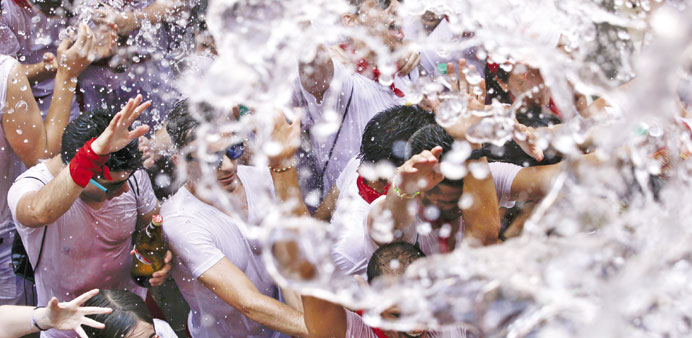Revellers get soaked with water during the start of the San Fermin Festival in Pamplona. The festival, best known for its daily running of the bulls, kicked off yesterday with the traditional ‘Chupinazo’ rocket launch and will run until July 14.
AFP/Pamplona
A sea of revellers decked in red and white sprayed wine on each other in a packed Pamplona square yesterday to kick off Spain’s famed San Fermin running of the bulls festival.
The nine-day street party got underway at midday with the cry “Viva San Fermin!” followed seconds later by the firing of a firecracker known locally as the “chupinazo”.
Crowds wearing traditional white outfits trimmed with red neckerchiefs and cummerbunds drank from traditional leather wine pouches and sprayed red wine on others. Others poured wine from balconies overhead.
Five giant outdoors television screens were set up at other points in the city centre and aired the event live.
Pamplona is located just south of the Rioja vineyard region and wine has for centuries played an important role in the celebrations, which commemorate San Fermin, the city’s first bishop and patron saint.
The festival, immortalised in Ernest Hemingway’s 1926 novel The Sun Also Rises, dates back to mediaeval times and features religious processions, folk dancing, concerts and round-the-clock drinking.
Just over six tonnes of fireworks will be set off during a nightly sound and light show during the festival which wraps up on July 14.
However, the highlight is a daily race of courage pitting hundreds of people against a pack of six half-tonne fighting bulls charging along a winding, 846.6m (more than half a mile) course through narrow streets to the city’s bull ring where the animals are killed in an afternoon bullfight.
The bravest run as close to the tips of the horns as possible without being gored.
The first bull run, which traditionally draws the largest number of participants, takes place today.
A run takes on average just under four minutes.
Dozens of daredevils are hospitalised each year. Most of the injuries are not caused by bull horns but by runners falling, or being knocked over and trampled by the animals.
Fifteen people have been killed in the bull runs since modern day records started in 1911.
The most recent death took place in 2009 when a bull gored a 27-year-old Spaniard in the neck, heart and lungs.
Last year just over 17,000 people joined the festival’s eight daily bull runs with over half of them, 56%, coming from abroad, according to Pamplona city hall.
The United States, Australia, New Zealand and Britain accounted for the greatest number of foreigners. The vast majority of bull run participants are men.
The Navarra Hospitality Association forecast that hotel occupancy in the centre of Pamplona would average about 85% during the festival, about last year’s level.
“It is a unique festival,” the head of the association’s data department, Jorge Fernandez, told AFP, adding that revellers came from the world over right from the United States to Australia.
Pamplona city officials refused to provide an estimate for the number of visitors expected in the city of 300,000 residents this year.
But they said just under 1.3mn people took part in 2014 in the over 400 events linked to the run.
The regional government of Navarra said 3,350 police would patrol the streets to keep the events as safe as possible.
About 100 semi-naked animal rights activists daubed themselves with fake blood and stood outside of Pamplona’s bullring on Saturday holding signs that read: “Pamplona’s streets are stained with bull’s blood” in several languages.



